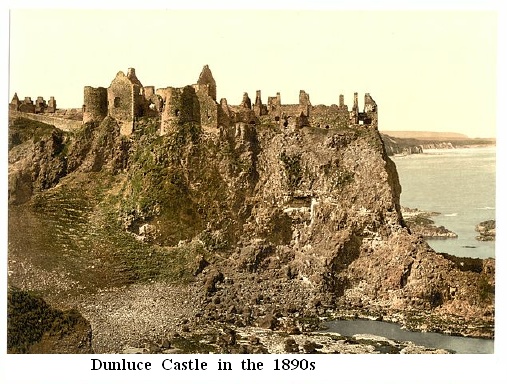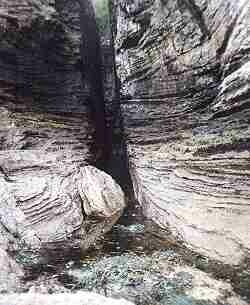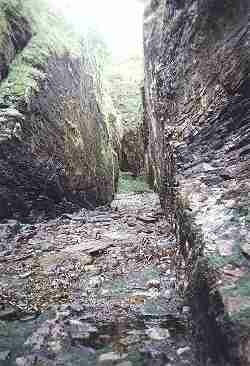The best feature of a belonging to a family association is meeting and getting to know your relatives. I was singularly blessed when I met my fifth cousin Frank McAlister in the early days of the Clan McAlister of America. Since that time, we have worked together on various tasks for the good of the CMA, most notably the continuation of Paul Towry's family research and computer data base. Frank and his family live about a mile from Mary Ellen and myself in Arlington, Virginia, which makes our collaboration convenient.
This past summer, Frank and his family visited a small town in Maine while they were on vacation. There were a number of books in the house where they stayed, one of which was The Poetical Works of Sir Walter Scott, published in Boston in 1856. Complete with illustrations, this book fascinated Frank, his wife Debbie, and their children, Scott and Elizabeth, since it included poems about areas with which most Scottish McAlisters are familiar.
The book included the poem, "The Lord of the Isles", the introduction to which Sir Walter Scott wrote at Abbotsford on December 10, 1814:
"The scene of the poem lies, at first, in the castle of Artornish, on the coast of Argyllshire; and, afterwards, in the Islands of Skye and Arran, and upon the coast of Ayrshire. Finally it is laid near Stirling. The story opens in the spring of the year 1307, when Bruce, who had been driven out of Scotland by the English, and the barons who adhered to that foreign interest, returned from the Island of Rachrie, on the coast of Ireland, again to assert his claims to the Scottish crown...."

During our trip to Ireland in the spring of 1998, my wife and I saw Rathlin (Reachlainn) Island a few miles off the coast, north of Ballycastle harbor in County Antrim, a feature of which is Bruce's Cave. Unfortunately, we were on a tour and time did not permit a visit to the island. In the vicinity to the west of Ballycastle, near the Giant's Causeway, is Dunluce Castle, sometimes referred to as McAlister's Castle.
In Canto III of "The Lord of the Isles", stanza XXVIII, there are the following lines:
'And mermaid's alabaster grot,
Who bathes her limbs in sunless well
Deep in Strathaird's enchanted cell.'
Sir Walter Scott's book includes notes that he wrote explaining many of the people and places in the poems. He wrote the following comment on Strathaird's enchanted cell:
"Imagination can hardly conceive any thing more beautiful that the extraordinary grotto discovered not many years since upon the estate of Alexander MacAllister, Esq., of Strathaird. It has since been much and deservedly celebrated, and a full account of its beauties has been published by Dr. MacLeay of Oban. The first entrance to this celebrated cave is rude and unpromising; but the light of the torches with which we were provided, was soon reflected upon the roof, floor and walls, which seems as if they were sheeted with marble.... The floor forms a steep and difficult ascent.... Upon attaining the summit of this ascent, the cave opens into a splendid gallery, adorned with the most dazzling crystalizations, and finally descends with rapidity to the brink of a pool of the most limpid water, about four or five yards broad. There opens beyond this pool a
seems as if they were sheeted with marble.... The floor forms a steep and difficult ascent.... Upon attaining the summit of this ascent, the cave opens into a splendid gallery, adorned with the most dazzling crystalizations, and finally descends with rapidity to the brink of a pool of the most limpid water, about four or five yards broad. There opens beyond this pool a portal arch, formed by two columns of white spar, with beautiful chasing upon the sides.... The pool, ... surrounded by the most fanciful mouldings, in a substance resembling white marble, and distinguished by the depth and purity of its waters, might have been the bathing grotto of a naiad... Mr. MacAllister of Strathaird has, with great propriety, built up the exterior entrance to this cave, in order that strangers may enter properly attended by a guide...."
portal arch, formed by two columns of white spar, with beautiful chasing upon the sides.... The pool, ... surrounded by the most fanciful mouldings, in a substance resembling white marble, and distinguished by the depth and purity of its waters, might have been the bathing grotto of a naiad... Mr. MacAllister of Strathaird has, with great propriety, built up the exterior entrance to this cave, in order that strangers may enter properly attended by a guide...."
Unfortunately, later Victorian visitors blackened the ceilings with the soot from their flares and removed many stalactites as souvenirs, but the cave and its approaches remain a wonderful example of nature's beauty and grandeur. N.B. The cave can only be accessed for a hour or so either side of low tide, so check the tide state and give yourself plenty of time either side of low water to to get in, explore and get back out!
According to my records, the Clachaid estate was purchased by Alexander MacAllister in 1786, and then he purchased Strathaird on the Isle of Skye. He was married first to a Miss Campbell of Ederline, Argyll, and second to a Miss McLeod, who was born on the Isle of Skye. His family line designation is MAC1-1-1-1-1-1-1-1-3-1-1-3-1, meaning that he is a twelfth generation descendant of Alasdair Mor. One of the members of the Australian Clan MacAlister Society, Max Milton Macalister, is descended from Alexander MacAllister.
Robert M. McAllisterFall 1999